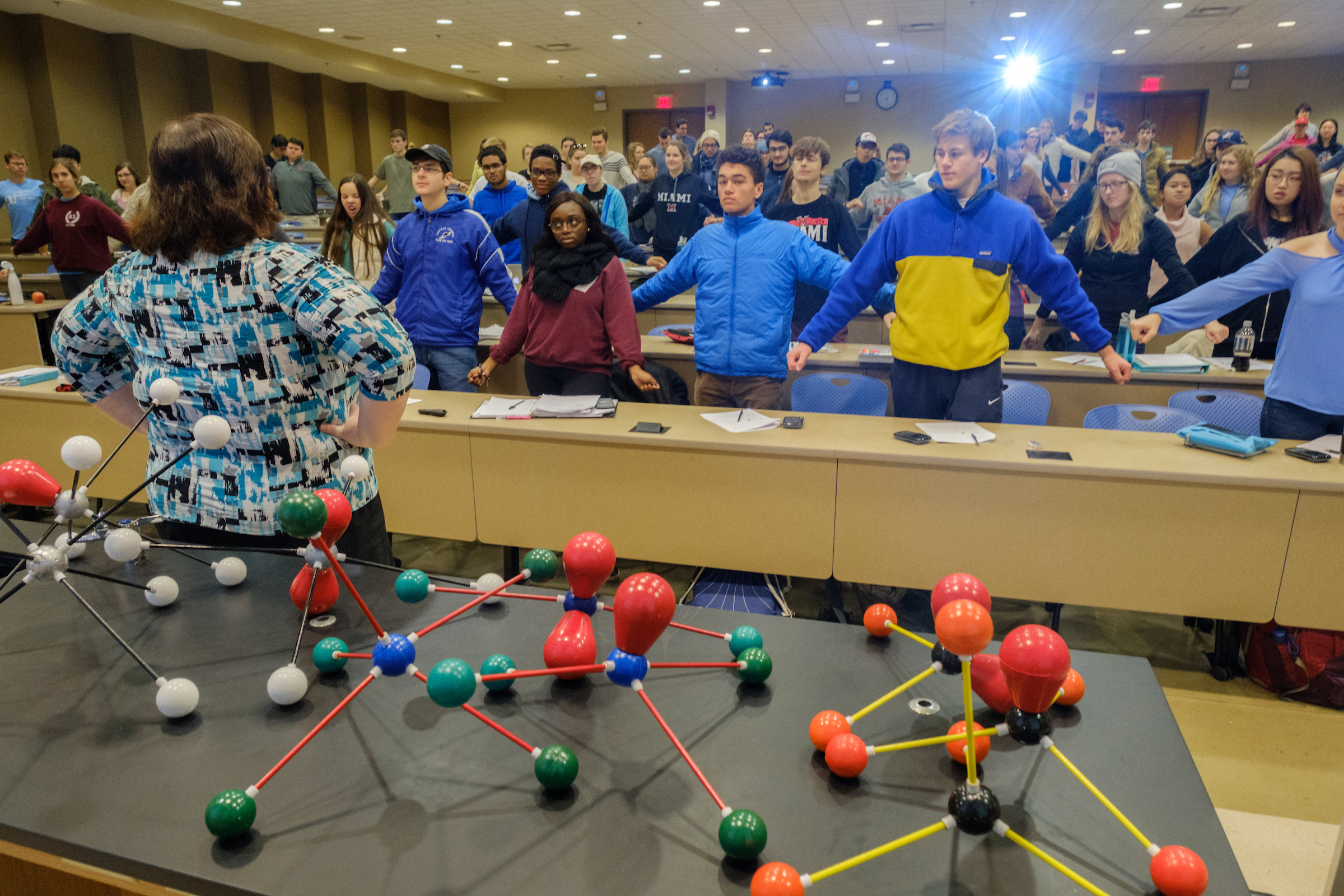HCWE/CTE Workshop Considers Authentic Assessment in Large Courses

Stacey Lowery Bretz (CHM) believes that no matter the size of a class, students can still have dynamic learning experiences supported by strategic, scaffolded assessments. Those sentiments were the guiding message in the Jan. 11 workshop “Authentic Assessment in Large Courses,” co-hosted by the Howe Center for Writing Excellence (HCWE) and the Center for Teaching Excellence (CTE) featuring Bretz, Mike Brudzinski (GLG) and Scott Sander (EDT).
Bretz teaches Chem 141 & 142, introductory classes of predominately non-majors that meet three times per week and can enroll as many as 1000 students in a given semester. Traditionally, such a class might entail the professor lecturing, students listening (but rarely discussing the material with one another), and 3 high-stakes exams that account for most of the course grade. Bretz reminded participants that such an approach doesn’t align with what research tells us about how students learn.
Rather than rely on infrequent, high-stakes summative assessments, Bretz builds in frequent, no- and low-stakes formative assessments. Some include embodied cognition experiences, like chemistry theater where students physically act out molecular motion (see image below). Of course there are still exams. Bretz, however, makes them open-note. She’s more interested in students being able to think through the conceptual framework behind questions than just arriving at correct answers. Since the online transition brought about by COVID-19, Bretz has steered clear of proctoring platforms for exams. She takes care to write exam questions that require critical thinking and application, and which are not easily Googled.

Dr. Stacey Lowery Bretz leads an embodied cognition activity to help
students figure out the shapes and bond angles in molecules.
Brudzinski, too, teaches a large class in the sciences. His environmental geology class (GLG 121) moved online several years pre-COVID-19. He's worked to make the online class an engaging learning space guided by critical thinking.
Brudzinski calls his instructional model “tutorial-based active E-learning.” Short lectures and texts set students up for concrete, real-world practice in scientific computing. During these hands-on computing exercises, students receive instruction and evaluation from an interactive assessment enabled by the learning management system. The stakes of the assignment are clear. It’s worth points, but incorrect answers trigger tailored responses and students get the opportunity to answer again for partial credit.
Thus, getting an answer wrong is not the end but the beginning. Students are encouraged to learn what they don’t understand and reconsider the question. The goal is learning, not gatekeeping.
Scott Sander teaches large classes filled with the next generation of science educators. His own teaching practices demonstrate how assessments focused on synthesis accomplish more than those focused on summary. While an approach grounded in summary can reveal empirical knowledge, teaching toward synthesis encourages students to use what they know to arrive at new insights and form emergent connections.
In Sander’s large EDT 181/182 class, he presents information on geology and astronomy always with the context of culture, identity, and power. By considering questions like "What counts as evidence? Who gets to decide? Can the pieces we see be put together in another way? and Will the 'answer' we have today ever change?," students in the course build a more personal relationship with the content information which will allow them to work with young children in more flexible ways. These are questions that can be used to build understanding of phenomena in both the physical and social worlds.
Students learn to connect scientific concepts with social phenomena first with exit slips (a form of low-stakes assessment) following each class session. Throughout the semester, Sander scaffolds assessments of varying stakes and forms, including writing, videos, and graphic designs. By the end of the semester, students are well prepared to undertake a major synthesizing project that draws from many class resources.
In addition to providing their course examples, Bretz, Brudzinski, and Sander led breakout discussion groups where fellow large-class instructors shared challenges and successes with student assessment. One prevailing takeaway: use self-assessment and calibrated peer review (see CPR and Eli Review platforms). Students often learn best when they’re given the tools to reflect on their own comprehension and progress. By encouraging students to evaluate their own work, you’ll be following research-driven teaching principles and also cutting down on your grading load.
Want to continue learning best practices in assessment? This Spring, the HCWE is hosting a 3-part workshop series on “Designing Assessments for Deep Learning” and a workshop on “Guided Peer Review Tools.” Learn more and sign up at our events page. Check out the CTE’s calendar of events too.

